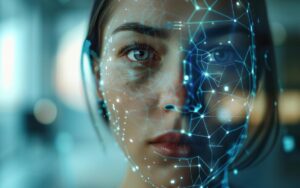Many of today’s information technologies aspire to mimic human behavior and thought processes as closely as possible. But do you realize that these efforts extend to imitating a human brain? The human brain is a marvel of organic engineering, and any attempt to create an artificial version will ultimately send the fields of Artificial Intelligence (AI) and Machine Learning (ML) to new heights.
This article tackles the question, “What is a neural network?” We will define the term, outline the types of neural networks, compare the pros and cons, explore neural network applications, and finally, a way for you to upskill in AI and machine learning.
So, before we explore the fantastic world of artificial neural networks and how they are poised to revolutionize what we know about AI, let’s first establish a definition.
What Is a Neural Network?
So, what is a neural network anyway? A neural network is a method of artificial intelligence, a series of algorithms that teach computers to recognize underlying relationships in data sets and process the data in a way that imitates the human brain. Also, it’s considered a type of machine learning process, usually called deep learning, that uses interconnected nodes or neurons in a layered structure, following the same pattern of neurons found in organic brains.
This process creates an adaptive system that lets computers continuously learn from their mistakes and improve performance. Humans use artificial neural networks to solve complex problems, such as summarizing documents or recognizing faces, with greater accuracy.
Neural networks are sometimes called artificial neural networks (ANN) to distinguish them from organic neural networks. After all, every person walking around today is equipped with a neural network. Neural networks interpret sensory data using a method of machine perception that labels or clusters raw input. The patterns that ANNs recognize are numerical and contained in vectors, translating all real-world data, including text, images, sound, or time series.
Artificial neural networks form the basis of large-language models (LLMS) used by tools such as chatGPT, Google’s Bard, Microsoft’s Bing, and Meta’s Llama.
Neural networks come in several types, listed below.
Also Read: Is AI Engineering a Viable Career?
What Are the Various Types of Neural Networks?
Here’s a rundown of the types of neural networks available today. Using different neural network paths, ANN types are distinguished by how the data moves from input to output mode.
Feed-forward Neural Networks
This ANN is one of the least complex networks. Information passes through various input nodes in one direction until it reaches the output node. For example, computer vision and facial recognition use feed-forward networks.
Recurrent Neural Networks
Recurrent neural networks are more complex than feed-forwards. They save processing node output and feed it into the model, a process that trains the network to predict a layer’s outcome. Each RNN model’s node is a memory cell that continues computation and implements operations. For example, ANN is usually used in text-to-speech conversions.
Convolutional Neural Networks
Convolution neural networks are one of today’s most popular ANN models. This model uses a different version of multilayer perceptrons, containing at least one convolutional layer that may be connected entirely or pooled. These layers generate feature maps that record an image’s region, are broken down into rectangles, and sent out. This ANN model is used primarily in image recognition in many of the more complex applications of Artificial Intelligence, like facial recognition, natural language processing, and text digitization.
Deconvolutional Neural Networks
This type of neural network uses a reversed CNN model process that finds lost signals or features previously considered irrelevant to the CNN system’s operations. This model works well with image synthesis and analysis.
Modular Neural Networks
Finally, modular neural networks have multiple neural networks that work separately from each other. These networks don’t communicate or interfere with each other’s operations during the computing process. As a result, large or complex computational processes can be conducted more efficiently.
Also Read: What is Machine Learning? A Comprehensive Guide for Beginners
What is a Neural Network and How Does a Neural Network Work?
Neural network architecture emulates the human brain. Human brain cells, referred to as neurons, build a highly interconnected, complex network that transmits electrical signals to each other, helping us process information. Likewise, artificial neural networks consist of artificial neurons that work together to solve problems. Artificial neurons comprise software modules called nodes, and artificial neural networks consist of software programs or algorithms that ultimately use computing systems to tackle math calculations. Nodes are called perceptrons and are comparable to multiple linear regressions. Perceptrons feed the signal created by multiple linear regressions into an activation function that could be nonlinear.
Here’s a look at basic neural network architecture.
- Input layer. Data from the outside world enters the ANN via the input layer. Input nodes process, analyze, and categorize the data, then pass it along to the next layer.
- Hidden layer. The hidden layer takes the input data from either the input layer or other hidden layers in the network. ANNs can have numerous hidden layers. Each of the network’s hidden layers analyzes the previous layer’s output, performs any necessary processing, then sends it along to the next layer.
- Output layer. The output layer produces the data processing’s final result created by the artificial neural network. The output layer can have single or multiple nodes. For example, if the problem is a binary (yes/no) classification issue, the output layer has just one output node, resulting in either 1 or 0. But if it’s a multi-class classification problem, the output layer can consist of multiple output nodes.
- Deep neural network architecture. Deep neural networks, also called deep learning networks, consist of numerous hidden layers containing millions of linked artificial neurons. A number, referred to as “weight,” represents the connections between nodes. Weight is a positive number if a node excites another and a negative number if a node suppresses another. The nodes with higher weight values influence the other nodes more.
A deep neural network can theoretically map any input to the output type. However, the network also needs considerably more training than other machine learning methods. Consequently, deep neural networks need millions of training data examples instead of the hundreds or thousands a simpler network may require.
Speaking of deep learning, let’s explore the neural network machine learning concept.
Machine Learning and Deep Learning: A Comparison
Standard machine learning methods need humans to input data for the machine learning software to work correctly. Then, data scientists determine the set of relevant features the software must analyze. This tedious process limits the software’s ability.
On the other hand, when dealing with deep learning, the data scientist only needs to give the software raw data. Then, the deep learning network extracts the relevant features by itself, thereby learning more independently. Moreover, it allows it to analyze unstructured data sets such as text documents, identify which data attributes need prioritization, and solve more challenging and complex problems.
Also Read: AI ML Engineer Salary – What You Can Expect
A Look at the Applications of Neural Networks
To get a more in-depth answer to the question “What is a neural network?” it’s super helpful to get an idea of the real-world applications they’re used for. Neural networks have countless uses, and as the technology improves, we’ll see more of them in our everyday lives. Here’s a partial list of how neural networks are being used today.
Speech Recognition
Let’s start off the list with one of the most popular applications. Neural networks can analyze human speech despite disparate languages, speech patterns, pitch, tone, and accents. Virtual assistants such as Amazon Alexa and transcription software use speech recognition to:
- Help call center agents and automatically classify calls
- Turn clinical conversations into documentation in real-time
- Place accurate subtitles in videos and meeting recordings
Computer Vision
Computer vision lets computers extract insights and information from images and videos. Using neural networks, computers can distinguish and recognize images as humans can. Computer vision is used for:
- Visual recognition in self-driving cars
- Content moderation that automatically removes inappropriate or unsafe content from image and video databases
- Facial recognition for identifying faces and recognizing characteristics such as open eyes, facial hair, and glasses
Natural Language Processing
Natural language processing (NLP) is a computer’s ability to process natural, human-made text. Neural networks aid computers in gathering insights and meaning from documents and other text data. NLP has many uses, including:
- Automated chatbots and virtual agents
- Automatically organizing and classifying written data
- Business intelligence (BI) analysis of long-form documents such as e-mails, contracts, and other forms
- Indexing key phrases that show sentiment, such as positive or negative comments on social media posts
Recommendation Engines
If you’ve ever ordered something online and later noticed that your social media newsfeed got flooded with recommendations for related products, congratulations! You’ve encountered a recommendation engine! Neural networks can track user activity and use the results to develop personalized recommendations. They can also analyze all aspects of a user’s behavior and discover new products or services that could interest them.
Pro tip: You can gain practical experience working on these applications in an interactive AI/ML bootcamp.
Also Read: What are Today’s Top Ten AI Technologies?
What is a Neural Network: Advantages and Disadvantages of Neural Networks
Neural networks bring plenty of advantages to the table but also have downsides. So let’s break things down into a list of pros and cons.
Advantages of Neural Networks
Neural networks have a lot going for them, and as the technology gets better, they will only improve and offer more functionality.
- Parallel processing abilities allow the network to perform multiple jobs simultaneously.
- The neural network can learn from events and make decisions based on its observations.
- Information gets accessed faster because it’s stored on an entire network, not just in a single database.
- Thanks to fault tolerance, neural network output generation won’t be interrupted if one or more cells get corrupted.
- Gradual corruption means the network degrades slowly over time rather than the network getting instantly destroyed by a problem. So, IT staff has time to address the problem and root out the corruption.
- The ANNs can produce output with incomplete information, and performance loss will be based on how important the missing information is. Consequently, output production doesn’t have to be interrupted due to irrelevant information not being available.
- ANNs can learn hidden relationships in the data without commanding any fixed relationships, so the network can better model highly volatile data and non-constant variances.
- Neural networks can generalize and infer relationships that would otherwise have gone unnoticed on unseen data, thus predicting the output of unseen data.
Disadvantages of Neural Networks
Unfortunately, it’s not all sunshine and smooth sailing. Neural networks aren’t perfect and have their drawbacks.
- Neural networks are bad at the “show your work” requirement. ANNs are saddled with the inability to explain their solutions’ hows and whys, thus breeding a lack of trust in the process. This situation is possibly the biggest drawback of neural networks.
- Neural networks are hardware-dependent because they require processors with parallel processing abilities.
- Since there aren’t any rules for determining proper network structures, data scientists must resort to trial and error and user experience to find the appropriate artificial neural network architecture.
- Neural networks operate with numerical information; thus, all problems must be converted into numerical values before the ANN can work on them.
Do You Want More Training in the Field of Artificial Intelligence?
Neural networks are gaining in popularity, so if you’re interested in an exciting career in a technology that’s still in its infancy, consider taking an AI course and setting your sights on an AI/ML position.
This six-month course provides a high-engagement learning experience that teaches concepts and skills such as computer vision, deep learning, speech recognition, neural networks, NLP, and much more.
The job website Glassdoor.com reports that an Artificial Intelligence Engineer’s average yearly salary in the United States is $105,013. So, if you’re ready to claim a good seat at the table of an industry that’s still new and growing, getting in at the ground floor of this exciting technology while enjoying excellent compensation, consider this bootcamp and get that ball rolling.
You might also like to read:
The Future of AI: A Comprehensive Guide






